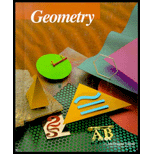
a.
To explain:
a.
Answer to Problem 4WE
Explanation of Solution
Given information:
Sphere is cut by a plane Z.
In sphere all points on surface are equidistant from the center when the plane cuts the sphere. Since all three given points; R, S, and T lie on the surface of the sphere, they are also equidistant from the point Q, which is the centre of the sphere.
Hence,
b.
To explain: why the intersection of a plane and a sphere is a
b.
Answer to Problem 4WE
Figure is a circle.
Explanation of Solution
Given information:
Sphere is cut by a plane Z.
Since we know that the intersection of any plane passing through the centre of the sphere forms a great circle and a sphere is a three − dimensional symmetric version of a circle (with varying radius), then the figure so formed by the intersection of a plane and a sphere is always a circle.
Chapter 9 Solutions
McDougal Littell Jurgensen Geometry: Student Edition Geometry
Additional Math Textbook Solutions
Algebra and Trigonometry (6th Edition)
Elementary Statistics (13th Edition)
A First Course in Probability (10th Edition)
Elementary Statistics
Calculus for Business, Economics, Life Sciences, and Social Sciences (14th Edition)
Calculus: Early Transcendentals (2nd Edition)
 Elementary Geometry For College Students, 7eGeometryISBN:9781337614085Author:Alexander, Daniel C.; Koeberlein, Geralyn M.Publisher:Cengage,
Elementary Geometry For College Students, 7eGeometryISBN:9781337614085Author:Alexander, Daniel C.; Koeberlein, Geralyn M.Publisher:Cengage, Elementary Geometry for College StudentsGeometryISBN:9781285195698Author:Daniel C. Alexander, Geralyn M. KoeberleinPublisher:Cengage Learning
Elementary Geometry for College StudentsGeometryISBN:9781285195698Author:Daniel C. Alexander, Geralyn M. KoeberleinPublisher:Cengage Learning

